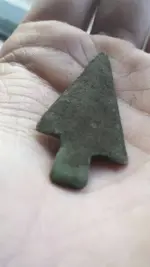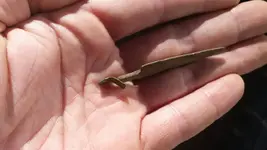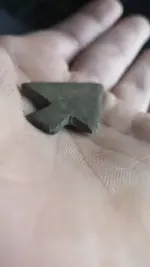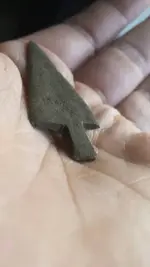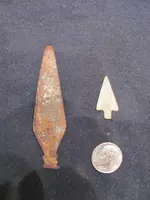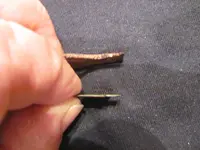You are using an out of date browser. It may not display this or other websites correctly.
You should upgrade or use an alternative browser.
You should upgrade or use an alternative browser.
Archaic Copper point
- Thread starter Glenn C
- Start date
CRUSADER
Emerald Member
Man... what the heck happened in here?
I tried to understand, my mistake.
Amazon Forum Fav 👍
CRUSADER
Emerald Member
Cru,
Ironically the experts on archaic copper culture are mostly amateur detectorists....very little expertise by the archeological crowd when it comes to these finds....I've seen hundreds of these items posted on the Canadian forum over the years....so I have a pretty good feel for those which are the real mccoy.
This item threw me off somewhat because most of the items I've seen posted have very heavy verdigris....but like Glenn stated over time the pieces will eventually take on a blackish tint...Glenn has done his due dilligence so take him at his word that this is the real deal.
Regards + HH
Bill
I cant now & no one can because the pictures never lie...lol ie....there are none. Maybe I will reserve my comments to 'nice finds', but maybe we all know better...lol
PS. No issue with patina was raised by me.
Glenn C
Sr. Member
- #43
Thread Owner
If you can find me evidence of trade copper sheet(kettle metal) being over 2mm thick, you may be right, its hard reading to find that. I have not found such a thing hence standing by what i see. I have been wrong before god knows..the middle of the point is half the thickness as the sides...anyway....
CRUSADER
Emerald Member
If you can find me evidence of trade copper sheet(kettle metal) being over 2mm thick, you may be right, its hard reading to find that. I have not found such a thing hence standing by what i see. I have been wrong before god knows..the middle of the point is half the thickness as the sides...anyway....
I'm not trying to be 'right'. I'm trying to understand the manufacturing process & the possible date range. For all 'we' know an over 2mm thick sheet system with a cutting tool might exist? My gut is that its done in the last 500 years, but there might be a technique which hasn't been demonstrated yet which pushes that back a 1000 years. Lets just work together to prove it either way. Am I just talking crazy, or can you see any sense in my points?
bill from lachine
Platinum Member
Cru/Glenn,
Please go your neutral corners and calm down....lol...
Regards + HH
Bill
Please go your neutral corners and calm down....lol...
Regards + HH
Bill
CRUSADER
Emerald Member
Cru/Glenn,
Please go your neutral corners and calm down....lol...
Regards + HH
Bill
Always calm.
CRUSADER
Emerald Member
im lost at the thickness of kettle metal..if i knew that i could be sure. So i will call it a arrow found in the woods until i know.I seriously cant find that info..copper anyway, so i like copper, was worth it.
I am really sorry you felt the need to delete. I have been there & I must of got under your skin. It was not my intention, & it was a great find however we 'label' it. I stick by what I said, because I always state what I see, but that doesn't mean I'm right, far from it. I just like to understand.
Last edited:
im lost at the thickness of kettle metal..if i knew that i could be sure. So i will call it a arrow found in the woods until i know.I seriously cant find that info..copper anyway, so i like copper, was worth it.
In the link below it describes the kettle metal having other properties so it's not pure copper. Simple to do just go to a larger scrap yard and they'll have a spectrograph for metals, just get them to flash the item and it'll tell you is a few seconds the copper content. If there's impurities then it's kettle copper brought over from Europe.
https://books.google.ca/books?id=CT... thick were 17 century copper kettles&f=false
CRUSADER
Emerald Member
In the link below it describes the kettle metal having other properties so it's not pure copper. Simple to do just go to a larger scrap yard and they'll have a spectrograph for metals, just get them to flash the item and it'll tell you is a few seconds the copper content. If there's impurities then it's kettle copper brought over from Europe.
https://books.google.ca/books?id=CT... thick were 17 century copper kettles&f=false
I think we are falling in to a trap of either its kettle metal or archaic. I have no opinion either way, because for all I know there is another 'unknown' option or explaination.
villagenut
Gold Member
Sorry I never got to see it. Sounds like it was a pretty cool find, congrats on finding it

relic lover
Bronze Member
- Joined
- Jul 4, 2006
- Messages
- 2,212
- Reaction score
- 1,310
- Golden Thread
- 0
- Location
- Western PA
- Detector(s) used
- Minelab Explorer SE With a plethora of coils
- Primary Interest:
- All Treasure Hunting
Where's the pictures?
old digger
Gold Member
I believe what you have there is a metal or copper trade point. In historic times the native Indians were also known to acquire metals and fashion their own points. Some of those trade points were crudely made, and were not presharpened.
old digger
Gold Member
ColonialDude
Hero Member
Point
Most definitely historic period....that said it certainly doesn't appear to be kettle brass and you're right, it's quite thick for that. Beautiful find Glenn.
Your statement reference collectors not understanding your finds is not accurate although I get where you're coming from. There are certainly fewer people with knowledge on this stuff...but I've definitely got a handle on fur trade stuff as well as Native American artifacts.
keep sharing!
CRUSADER
Emerald Member
Point
Thanks for putting the pictures back up, it will make a good reference for other comparisons in the future.
I think I'm getting the sense that these things are under studied. Are you able to work with archies (the right ones), because it sounds like there is a lot to learn from each other.
OWK
Hero Member
- Joined
- Apr 26, 2014
- Messages
- 998
- Reaction score
- 1,292
- Golden Thread
- 0
- Location
- North Central Md
- Detector(s) used
- Fisher F70, F75
Garrett Pinpointer
- Primary Interest:
- All Treasure Hunting
Glenn C,
You have found something interesting, and fostered a lot of discussion. Whether this find is archaic or not, it is beautiful. That said, I'd ask you not to consider others' opinions about this piece as a personal challenge. Part of the good that comes from discussion of these types of artifacts, is the opportunity to learn. People will offer opinions. Some may be right, some may be wrong. Discussion will involve points, and counter-points. In the end, everyone benefits.
Relax, and enjoy the discussion.
That said, I'll throw in my two cents. I'd learn toward a trade interpretation to the piece. I would agree with you that it is unusually thick. But looking at the base, it appears to be cut to shape. That alone would suggest to me at least, that it is not archaic.
You have found something interesting, and fostered a lot of discussion. Whether this find is archaic or not, it is beautiful. That said, I'd ask you not to consider others' opinions about this piece as a personal challenge. Part of the good that comes from discussion of these types of artifacts, is the opportunity to learn. People will offer opinions. Some may be right, some may be wrong. Discussion will involve points, and counter-points. In the end, everyone benefits.
Relax, and enjoy the discussion.
That said, I'll throw in my two cents. I'd learn toward a trade interpretation to the piece. I would agree with you that it is unusually thick. But looking at the base, it appears to be cut to shape. That alone would suggest to me at least, that it is not archaic.
Plumbata
Bronze Member
Very nice find! I agree about it being a fur trade era point, maybe a small spearhead which would account for the thickness. I collect metal spearheads/arrowheads (guess what a plumbata is, lol) and recently saw a large number of copper fur trade points being liquidated through eBay, some much thicker than kettle arrowheads. The tang area looks to have been formed by expedient cold-cutting with a (steel or iron) chisel, and the uniform patina without the "worm tracks" one sees on archaic pieces suggests it is a piece of copper that was smelted and relatively homogeneous, versus made from a raw chunk of native copper with different zones that are more or less prone to environmental chemical attack.
It is a great find, and I'd encourage you to post future Copper Culture through Historic metal finds here, I always love seeing them, especially socketed examples.
It is a great find, and I'd encourage you to post future Copper Culture through Historic metal finds here, I always love seeing them, especially socketed examples.
Similar threads
D
- Replies
- 13
- Views
- 748
- Replies
- 10
- Views
- 1K
Users who are viewing this thread
Total: 1 (members: 0, guests: 1)




